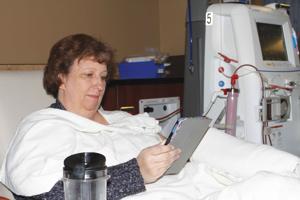From Medical Xpress
New answers for kids with inherited kidney disease

University of Queensland researchers were part of the team that made the discovery that will improve genetic testing and could provide clues for future treatments for autosomal recessive polycystic kidney disease (ARPKD).
UQ Institute for Molecular Bioscience researcher Associate Professor Carol Wicking, a lead author of the study, said it had previously been difficult to determine the underlying cause of all cases of ARPKD.
"It was thought that errors in a gene called PKHD1 were solely to blame for this rare form of kidney disease," Associate Professor Wicking said.
"But there was always a subset of patients who appeared to have the disease, even though they possessed a normal version of that gene.
"The aim of this study was to find other genetic culprits that could be responsible for this devastating condition."
ARPKD causes enlarged kidneys, liver problems and high blood pressure, and often leads to renal failure in the 70 per cent of patients who survive the first weeks of life.
Using a technique called whole exome sequencing to analyse all of a patient's genes simultaneously, researchers in Germany and the US found errors in a gene called DZIP1L in four families with ARPKD.
Associate Professor Wicking and colleagues in Australia, Singapore and Germany used laboratory-based models to confirm that errors in this gene did indeed cause kidney defects, and began to explore and understand why.
"The gene DZIP1L appears to be related to the function of cilia, which are small antenna-like extensions that project from almost all cells of the body, including those in the kidney, and play an important role in controlling vital cellular functions," Associate Professor Wicking said.
"This gene makes a protein that acts at the base of the cilium, which, when faulty, causes a domino effect that leads to problems in cilia and, in turn, a malfunctioning kidney.
"ARPKD has a more complex cause than originally thought, and our work to understand this rare disease may eventually help us to better manage both rare and more common forms of polycystic kidney disease."
Many patients with a rare disease wait years for a genetic diagnosis and often endure multiple misdiagnoses.
Rare Voices Australia Executive Director Nicole Millis said this exciting discovery provided much-needed answers for patients.
"These findings highlight how new genomic technologies are helping to find answers for patients with rare diseases, giving them more certainty about their condition.
"Having a genetic diagnosis also gives patients and their families a chance to connect with other people living with a similar rare disease and build vital support networks," Ms Millis said.
The research is published in Nature Genetics.
From Business Wire
“We are very pleased to be developing lixivaptan as our first product,” said Lorenzo Pellegrini, Ph.D., Founder and Chief Executive Officer of Palladio. “We believe that lixivaptan may be able to delay the progression of PKD, thus decreasing the need for dialysis and/or kidney transplant and potentially extending the lives of patients with PKD.”
In conjunction with the lixivaptan acquisition, Palladio closed on a Series A venture round led by Medicxi, one of Europe’s largest dedicated life sciences venture capital firms. Michele Ollier, MD, Partner and co-founder of Medicxi, and Jonathan Edwards, Ph.D. principal at Medicxi, have joined the Board of Directors of Palladio Biosciences.
"We are excited to be supporting Palladio Biosciences," said Michele Ollier, MD. "Lixivaptan represents a late stage, de-risked orphan development program in an area of high unmet need with no treatment approved in the US."
"We are pleased to have completed this transaction with Palladio Biosciences in an effort to bring this important medicine to PKD patients worldwide," stated Ken McBean, President and CEO at Chiesi USA, Inc. "As a company focused on developing treatments to address important unmet medical needs, we are glad that Palladio is committed to the development of this product."
About Lixivaptan:
Lixivaptan is a selective vasopressin V2 receptor antagonist. This mechanism of action has clinical proof of concept to delay the progression of the autosomal dominant form of PKD. Lixivaptan was previously administered to more than 1,600 subjects across 36 clinical studies as part of a prior clinical development program for the treatment of hyponatremia. Palladio expects to leverage this extensive data package and the learnings from recent PKD drug development activities to advance lixivaptan for PKD.
About Polycystic Kidney Disease (PKD) - Key Facts and Figures:
PKD is an inherited genetic disease that affects thousands of people in the United States and millions globally. The disease is characterized by uncontrolled growth of fluid-filled cysts in the kidney, which can each grow to be as large as a football. The continued enlargement of cysts and replacement of normal kidney tissue causes irreversible loss of renal function. In the United States, approximately 2,500 new people with PKD require dialysis or a kidney transplant every year, making PKD the 4th leading cause of kidney failure. There is no cure for PKD.









